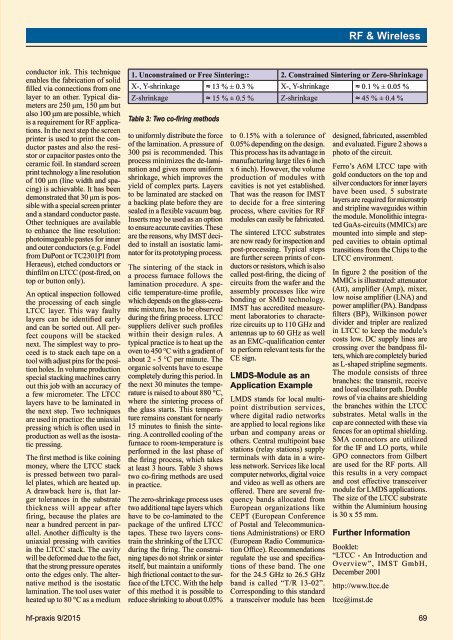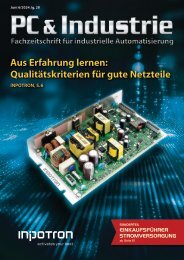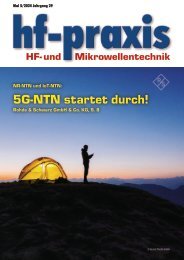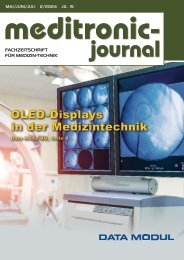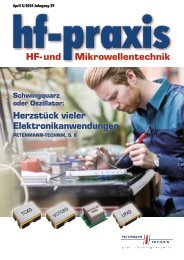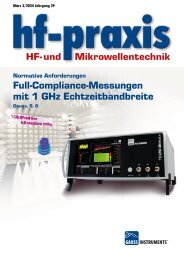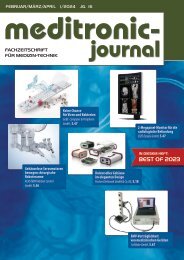9-2015
Fachzeitschrift für Hochfrequenz- und Mikrowellentechnik
Fachzeitschrift für Hochfrequenz- und Mikrowellentechnik
Erfolgreiche ePaper selbst erstellen
Machen Sie aus Ihren PDF Publikationen ein blätterbares Flipbook mit unserer einzigartigen Google optimierten e-Paper Software.
RF & Wirelessconductor ink. This techniqueenables the fabrication of solidfilled via connections from onelayer to an other. Typical diametersare 250 μm, 150 μm butalso 100 μm are possible, whichis a requirement for RF applications.In the next step the screenprinter is used to print the conductorpastes and also the resistoror capacitor pastes onto theceramic foil. In standard screenprint technology a line resolutionof 100 μm (line width and spacing)is achievable. It has beendemonstrated that 30 μm is possiblewith a special screen printerand a standard conductor paste.Other techniques are availableto enhance the line resolution:photoimageable pastes for innerand outer conductors (e.g. Fodelfrom DuPont or TC2301PI fromHeraeus), etched conductors orthinfilm on LTCC (post-fired, ontop or button only).An optical inspection followedthe processing of each singleLTCC layer. This way faultylayers can be identified earlyand can be sorted out. All perfectcoupons will be stackednext. The simplest way to proceedis to stack each tape on atool with adjust pins for the positionholes. In volume productionspecial stacking machines carryout this job with an accuracy ofa few micrometer. The LTCClayers have to be laminated inthe next step. Two techniquesare used in practice: the uniaxialpressing which is often used inproduction as well as the isostaticpressing.The first method is like coiningmoney, where the LTCC stackis pressed between two parallelplates, which are heated up.A drawback here is, that largertolerances in the substratethickness will appear afterfiring, because the plates arenear a hundred percent in parallel.Another difficulty is theuniaxial pressing with cavitiesin the LTCC stack. The cavitywill be deformed due to the fact,that the strong pressure operatesonto the edges only. The alternativemethod is the isostaticlamination. The tool uses waterheated up to 80 °C as a medium1. Unconstrained or Free Sintering:: 2. Constrained Sintering or Zero-ShrinkageX-, Y-shrinkage ≈ 13 % ± 0.3 % X-, Y-shrinkage ≈ 0.1 % ± 0.05 %Z-shrinkage ≈ 15 % ± 0.5 % Z-shrinkage ≈ 45 % ± 0.4 %Table 3: Two co-firing methodsto uniformly distribute the forceof the lamination. A pressure of300 psi is recommended. Thisprocess minimizes the de-laminationand gives more uniformshrinkage, which improves theyield of complex parts. Layersto be laminated are stacked ona backing plate before they aresealed in a flexible vacuum bag.Inserts may be used as an optionto ensure accurate cavities. Theseare the reasons, why IMST decidedto install an isostatic laminatorfor its prototyping process.The sintering of the stack ina process furnace follows thelamination procedure. A specifictemperature-time profile,which depends on the glass-ceramicmixture, has to be observedduring the firing process. LTCCsuppliers deliver such profileswithin their design rules. Atypical practice is to heat up theoven to 450 °C with a gradient ofabout 2 - 5 °C per minute. Theorganic solvents have to escapecompletely during this period. Inthe next 30 minutes the temperatureis raised to about 880 °C,where the sintering process ofthe glass starts. This temperatureremains constant for nearly15 minutes to finish the sintering.A controlled cooling of thefurnace to room-temperature isperformed in the last phase ofthe firing process, which takesat least 3 hours. Table 3 showstwo co-firing methods are usedin practice.The zero-shrinkage process usestwo additional tape layers whichhave to be co-laminated to thepackage of the unfired LTCCtapes. These two layers constrainthe shrinking of the LTCCduring the firing. The constrainingtapes do not shrink or sinteritself, but maintain a uniformlyhigh frictional contact to the surfaceof the LTCC. With the helpof this method it is possible toreduce shrinking to about 0.05%to 0.15% with a tolerance of0.05% depending on the design.This process has its advantage inmanufacturing large tiles 6 inchx 6 inch). However, the volumeproduction of modules withcavities is not yet established.That was the reason for IMSTto decide for a free sinteringprocess, where cavities for RFmodules can easily be fabricated.The sintered LTCC substratesare now ready for inspection andpost-processing. Typical stepsare further screen prints of conductorsor resistors, which is alsocalled post-firing, the dicing ofcircuits from the wafer and theassembly processes like wirebonding or SMD technology.IMST has accredited measurementlaboratories to characterizecircuits up to 110 GHz andantennas up to 60 GHz as wellas an EMC-qualification centerto perform relevant tests for theCE sign.LMDS-Module as anApplication ExampleLMDS stands for local multipointdistribution services,where digital radio networksare applied to local regions likeurban and company areas orothers. Central multipoint basestations (relay stations) supplyterminals with data in a wirelessnetwork. Services like localcomputer networks, digital voiceand video as well as others areoffered. There are several frequencybands allocated fromEuropean organizations likeCEPT (European Conferenceof Postal and TelecommunicationsAdministrations) or ERO(European Radio CommunicationOffice). Recommendationsregulate the use and specificationsof these band. The onefor the 24.5 GHz to 26.5 GHzband is called “T/R 13-02”.Corresponding to this standarda transceiver module has beendesigned, fabricated, assembledand evaluated. Figure 2 shows aphoto of the circuit.Ferro’s A6M LTCC tape withgold conductors on the top andsilver conductors for inner layershave been used. 5 substratelayers are required for microstripand stripline waveguides withinthe module. Monolithic integratedGaAs-circuits (MMICs) aremounted into simple and steppedcavities to obtain optimaltransitions from the Chips to theLTCC environment.In figure 2 the position of theMMICs is illustrated: attenuator(Att), amplifier (Amp), mixer,low noise amplifier (LNA) andpower amplifier (PA). Bandpassfilters (BP), Wilkinson powerdivider and tripler are realizedin LTCC to keep the module’scosts low. DC supply lines arecrossing over the bandpass filters,which are completely buriedas L-shaped stripline segments.The module consists of threebranches: the transmit, receiveand local oscillator path. Doublerows of via chains are shieldingthe branches within the LTCCsubstrates. Metal walls in thecap are connected with these viafences for an optimal shielding.SMA connectors are utilizedfor the IF and LO ports, whileGPO connectors from Gilbertare used for the RF ports. Allthis results in a very compactand cost effective transceivermodule for LMDS applications.The size of the LTCC substratewithin the Aluminium housingis 30 x 55 mm.Further InformationBooklet:“LTCC - An Introduction andOverview”, IMST GmbH,December 2001http://www.ltcc.deltcc@imst.dehf-praxis 9/<strong>2015</strong> 69


